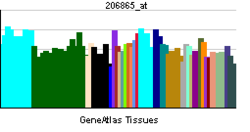- HRK (gene)
-
Harakiri, BCL2 interacting protein (contains only BH3 domain) Identifiers Symbols HRK; DP5; HARAKIRI External IDs OMIM: 603447 MGI: 1201608 HomoloGene: 37853 GeneCards: HRK Gene RNA expression pattern 

More reference expression data Orthologs Species Human Mouse Entrez 8739 12123 Ensembl ENSG00000135116 ENSMUSG00000046607 UniProt O00198 n/a RefSeq (mRNA) NM_003806 NM_007545.2 RefSeq (protein) NP_003797 NP_031571.1 Location (UCSC) Chr 12:
117.3 – 117.32 MbChr 5:
118.62 – 118.64 MbPubMed search [1] [2] Activator of apoptosis harakiri is a protein that in humans is encoded by the HRK gene.[1][2]
Activator of apoptosis Hrk regulates apoptosis through interaction with death-repressor proteins Bcl-2 and Bcl-X(L). The HRK protein lacks significant homology to other BCL2 family members except for an 8-amino acid region that was similar to the BCL2 homology domain-3 (BH3) motif of BIK. HRK interacts with BCL2 and BCLXL via the BH3 domain, but not with the death-promoting BCL2-related proteins BAX, BAK, or BCLXS. HRK localizes to membranes of intracellular organelles in a pattern similar to that previously reported for BCL2 and BCLXL.[2]
Interactions
HRK (gene) has been shown to interact with BCL2-like 1[1][3][4] and Bcl-2.[1][5]
References
- ^ a b c Inohara N, Ding L, Chen S, Nunez G (May 1997). "harakiri, a novel regulator of cell death, encodes a protein that activates apoptosis and interacts selectively with survival-promoting proteins Bcl-2 and Bcl-X(L)". EMBO J 16 (7): 1686–94. doi:10.1093/emboj/16.7.1686. PMC 1169772. PMID 9130713. http://www.pubmedcentral.nih.gov/articlerender.fcgi?tool=pmcentrez&artid=1169772.
- ^ a b "Entrez Gene: HRK harakiri, BCL2 interacting protein (contains only BH3 domain)". http://www.ncbi.nlm.nih.gov/sites/entrez?Db=gene&Cmd=ShowDetailView&TermToSearch=8739.
- ^ Whitfield, Jonathan; Harada Kokichi, Bardelle Catherine, Staddon James M (Nov. 2003). "High-throughput methods to detect dimerization of Bcl-2 family proteins". Anal. Biochem. (United States) 322 (2): 170–8. doi:10.1016/j.ab.2003.07.014. ISSN 0003-2697. PMID 14596824.
- ^ Imaizumi, K; Morihara T, Mori Y, Katayama T, Tsuda M, Furuyama T, Wanaka A, Takeda M, Tohyama M (Mar. 1999). "The cell death-promoting gene DP5, which interacts with the BCL2 family, is induced during neuronal apoptosis following exposure to amyloid beta protein". J. Biol. Chem. (UNITED STATES) 274 (12): 7975–81. doi:10.1074/jbc.274.12.7975. ISSN 0021-9258. PMID 10075695.
- ^ Chen, Lin; Willis Simon N, Wei Andrew, Smith Brian J, Fletcher Jamie I, Hinds Mark G, Colman Peter M, Day Catherine L, Adams Jerry M, Huang David C S (Feb. 2005). "Differential targeting of prosurvival Bcl-2 proteins by their BH3-only ligands allows complementary apoptotic function". Mol. Cell (United States) 17 (3): 393–403. doi:10.1016/j.molcel.2004.12.030. ISSN 1097-2765. PMID 15694340.
Further reading
- Imaizumi K, Morihara T, Mori Y, et al. (1999). "The cell death-promoting gene DP5, which interacts with the BCL2 family, is induced during neuronal apoptosis following exposure to amyloid beta protein.". J. Biol. Chem. 274 (12): 7975–81. doi:10.1074/jbc.274.12.7975. PMID 10075695.
- Hartley JL, Temple GF, Brasch MA (2001). "DNA cloning using in vitro site-specific recombination.". Genome Res. 10 (11): 1788–95. doi:10.1101/gr.143000. PMC 310948. PMID 11076863. http://www.pubmedcentral.nih.gov/articlerender.fcgi?tool=pmcentrez&artid=310948.
- Sanz C, Mellstrom B, Link WA, et al. (2001). "Interleukin 3-dependent activation of DREAM is involved in transcriptional silencing of the apoptotic Hrk gene in hematopoietic progenitor cells.". EMBO J. 20 (9): 2286–92. doi:10.1093/emboj/20.9.2286. PMC 125442. PMID 11331593. http://www.pubmedcentral.nih.gov/articlerender.fcgi?tool=pmcentrez&artid=125442.
- Bae J, Hsu SY, Leo CP, et al. (2001). "Underphosphorylated BAD interacts with diverse antiapoptotic Bcl-2 family proteins to regulate apoptosis.". Apoptosis 6 (5): 319–30. doi:10.1023/A:1011319901057. PMID 11483855.
- Wakabayashi T, Kosaka J, Hommura S (2002). "Up-regulation of Hrk, a regulator of cell death, in retinal ganglion cells of axotomized rat retina.". Neurosci. Lett. 318 (2): 77–80. doi:10.1016/S0304-3940(01)02487-9. PMID 11796190.
- Sanz C, Horita M, Fernandez-Luna JL (2004). "Fas signaling and blockade of Bcr-Abl kinase induce apoptotic Hrk protein via DREAM inhibition in human leukemia cells.". Haematologica 87 (9): 903–7. PMID 12217801.
- Strausberg RL, Feingold EA, Grouse LH, et al. (2003). "Generation and initial analysis of more than 15,000 full-length human and mouse cDNA sequences.". Proc. Natl. Acad. Sci. U.S.A. 99 (26): 16899–903. doi:10.1073/pnas.242603899. PMC 139241. PMID 12477932. http://www.pubmedcentral.nih.gov/articlerender.fcgi?tool=pmcentrez&artid=139241.
- Jurisicova A, Antenos M, Varmuza S, et al. (2003). "Expression of apoptosis-related genes during human preimplantation embryo development: potential roles for the Harakiri gene product and Caspase-3 in blastomere fragmentation.". Mol. Hum. Reprod. 9 (3): 133–41. doi:10.1093/molehr/gag016. PMID 12606589.
- Whitfield J, Harada K, Bardelle C, Staddon JM (2004). "High-throughput methods to detect dimerization of Bcl-2 family proteins.". Anal. Biochem. 322 (2): 170–8. doi:10.1016/j.ab.2003.07.014. PMID 14596824.
- Obata T, Toyota M, Satoh A, et al. (2004). "Identification of HRK as a target of epigenetic inactivation in colorectal and gastric cancer.". Clin. Cancer Res. 9 (17): 6410–8. PMID 14695142.
- Sunayama J, Ando Y, Itoh N, et al. (2005). "Physical and functional interaction between BH3-only protein Hrk and mitochondrial pore-forming protein p32.". Cell Death Differ. 11 (7): 771–81. doi:10.1038/sj.cdd.4401418. PMID 15031724.
- Chen L, Willis SN, Wei A, et al. (2005). "Differential targeting of prosurvival Bcl-2 proteins by their BH3-only ligands allows complementary apoptotic function.". Mol. Cell 17 (3): 393–403. doi:10.1016/j.molcel.2004.12.030. PMID 15694340.
- Kuwana T, Bouchier-Hayes L, Chipuk JE, et al. (2005). "BH3 domains of BH3-only proteins differentially regulate Bax-mediated mitochondrial membrane permeabilization both directly and indirectly.". Mol. Cell 17 (4): 525–35. doi:10.1016/j.molcel.2005.02.003. PMID 15721256.
- Certo M, Del Gaizo Moore V, Nishino M, et al. (2006). "Mitochondria primed by death signals determine cellular addiction to antiapoptotic BCL-2 family members.". Cancer Cell 9 (5): 351–65. doi:10.1016/j.ccr.2006.03.027. PMID 16697956.
Categories:- Human proteins
- Chromosome 12 gene stubs
Wikimedia Foundation. 2010.
